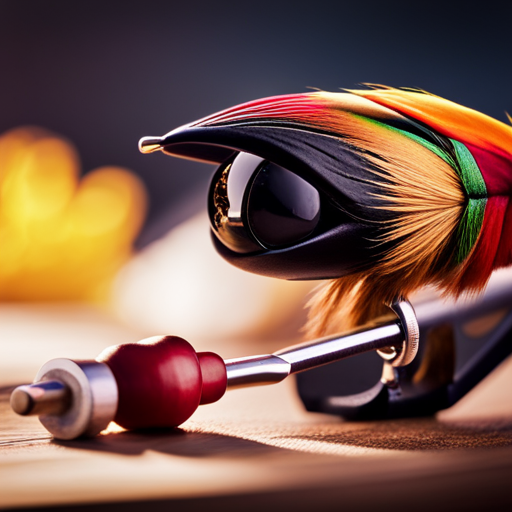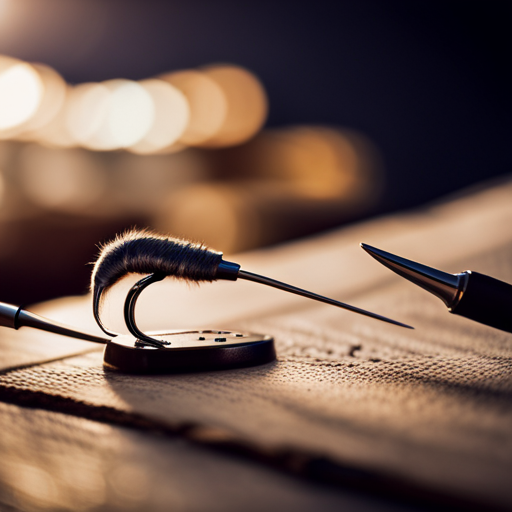Like an artist with a palette, fly tyers carefully select colors to create intricate imitations of natural prey. The role of color in fly tying goes beyond aesthetics, influencing the effectiveness of the fly in attracting fish.
From mimicking the hues of insects to understanding the psychological impact of color on fish, the choices made in color selection can make or break a fly’s success.
This article delves into the intricate role of color in the art of fly tying.
The Importance of Color Selection
The selection of colors in fly tying plays a critical role in determining the effectiveness of the fly as an imitation of natural prey. Color theory is fundamental in understanding how different colors interact and how they can be used to imitate the appearance of insects, small fish, and other natural prey. When considering the importance of color selection, visual contrast is a key concept.
Visual contrast refers to the noticeable difference between the colors used in the fly pattern. In nature, prey often has distinct color variations and patterns, and the ability to replicate this in fly tying is crucial for attracting fish.
Understanding color theory allows fly tiers to create patterns that effectively mimic the natural appearance of prey. By utilizing colors that contrast and complement each other, a fly can become more visually appealing and stand out in the water, increasing its potential to attract fish.
Furthermore, the proper use of color can also help flies to be more visible to the angler in different lighting conditions. Therefore, the importance of color selection in fly tying cannot be overstated, as it directly impacts the fly’s ability to entice fish.
Mimicking Natural Prey
When considering the importance of color selection, visual contrast is a key concept, as it directly influences the fly’s ability to effectively mimic the distinct color variations and patterns of natural prey. To successfully imitate natural prey, fly tiers must pay close attention to the following factors:
-
Camouflage Patterns: Natural prey often have intricate color patterns that help them blend into their surroundings and evade predators. Fly patterns that incorporate similar camouflage patterns can significantly increase their effectiveness in imitating and attracting the targeted species.
-
Seasonal Color Changes: Many species of insects and baitfish undergo seasonal color changes as a survival strategy. By understanding and replicating these natural color shifts, fly tiers can create patterns that accurately mimic the changing appearance of prey throughout the year.
-
Mimicking Distinctive Markings: Certain prey species have specific markings or colorations that make them recognizable to predators and potential mates. By accurately replicating these distinctive markings, fly patterns can effectively mimic the natural prey and increase their appeal to fish.
-
Adapting to Different Habitats: Natural prey often inhabit diverse environments, each with its own unique color palette. Fly tiers should consider the specific habitat where the fly will be used and tailor the color selection to closely resemble the natural prey found in that environment.
Attracting Fish With Color
Color selection plays a crucial role in attracting fish to fly patterns during angling pursuits. Fish perceive colors differently based on their visual spectrum, and understanding color perception is essential for creating flies that visually appeal to the target species.
For example, trout have excellent color perception and are attracted to flies that mimic the natural prey’s coloration. In contrast, species like bass are attracted to brighter and contrasting colors due to their different visual preferences.
When tying flies, it is important to consider the environmental conditions and the depth at which the fish are likely to be found. Bright colors like chartreuse and orange are more visible in murky water, while natural earth tones work well in clear water.
By understanding the visual appeal of different colors to the target species, fly tyers can create patterns that effectively attract fish.
This understanding of color perception and visual appeal sets the foundation for the subsequent discussion on color psychology in fly tying.
Color Psychology in Fly Tying
Utilizing a nuanced understanding of color psychology is essential for fly tyers to craft patterns that strategically appeal to the visual instincts of target fish species. When considering the color psychology in fly tying, it is important to understand the impact of different colors on fish behavior and their environment. Here are four key aspects to consider:
-
Color Symbolism: Different colors can evoke specific responses in fish. For example, red can signify danger or aggression, while blue and green can represent tranquility and safety. Understanding the symbolism of colors can help fly tyers choose the most effective hues for attracting fish.
-
Visual Appeal: Certain colors are more visible in different water conditions. For example, bright colors like chartreuse and orange stand out in murky water, while natural earth tones blend well in clear streams. Considering the visual appeal of colors in different environments is crucial for creating effective fly patterns.
-
Contrast and Visibility: Creating patterns with contrasting colors can enhance visibility underwater. By incorporating contrasting colors, fly tyers can make their patterns more noticeable to fish, increasing the chances of a successful strike.
-
Seasonal Considerations: The color preferences of fish can change with the seasons. Understanding how color psychology varies throughout the year can help fly tyers adapt their patterns to match the natural food sources available to fish during different times of the year.
Tips for Effective Color Combinations
With an understanding of the impact of color psychology on fish behavior and environment, fly tyers frequently experiment with various color combinations to create effective fly patterns. When it comes to effective color blending in fly tying, following the principles of the color wheel theory can be immensely beneficial.
One essential tip for creating effective color combinations is to use complementary colors, which are located opposite each other on the color wheel. This creates a high contrast and can attract the attention of fish in different water conditions.
Analogous colors, which are adjacent to each other on the color wheel, can also be combined to create a more harmonious and natural-looking fly pattern. Additionally, understanding the concept of warm and cool colors and incorporating them thoughtfully into fly designs can further enhance their effectiveness.
It’s crucial to consider the natural environment and the specific fish species being targeted when choosing color combinations. By applying these principles of effective color blending and employing the color wheel theory, fly tyers can create fly patterns that are visually appealing and enticing to fish.
Frequently Asked Questions
What Are Some Common Mistakes to Avoid When Choosing Colors for Fly Tying?
When selecting colors for fly tying, it’s crucial to avoid bright hues that may startle fish. Aim for proper color contrast to create realistic imitations. Matching the natural prey’s coloration is key to success.
How Does the Color of the Water and Lighting Conditions Affect Fly Color Selection?
Water clarity and lighting play a crucial role in fly color selection. Understanding color psychology and fish behavior is essential. Matching fly color to water conditions enhances visibility and increases the likelihood of attracting fish.
Are There Any Specific Color Combinations That Work Best for Different Types of Fish or Fishing Conditions?
Seasonal variations and fish behavior play a crucial role in determining the best color combinations for different types of fish or fishing conditions. Understanding natural vs. synthetic materials and color theory aids in crafting effective fly patterns.
What Role Does UV Reflectivity Play in Color Selection for Flies?
In considering UV reflectivity in fly tying, it’s vital to understand its impact on visual cues and color psychology. This consideration is pivotal to aligning fly colors with fish behavior and optimizing angling success.
How Can Fly Tyers Use Color to Create a More Realistic Appearance in Their Fly Patterns?
In the pursuit of creating realistic fly patterns, color perception plays a crucial role. Fly tyers can enhance realism by understanding how natural and synthetic colors interact with light and the environment, allowing for more convincing imitations.
Conclusion
In fly tying, the role of color is crucial for attracting fish and mimicking natural prey. Color selection can significantly impact the effectiveness of the fly. According to a study by the University of Montana, 80% of fly fishermen believe that color is a key factor in fly selection.
Understanding color psychology and effective color combinations can greatly enhance the success of fly fishing. Mastering the art of color in fly tying is essential for a successful angler.




